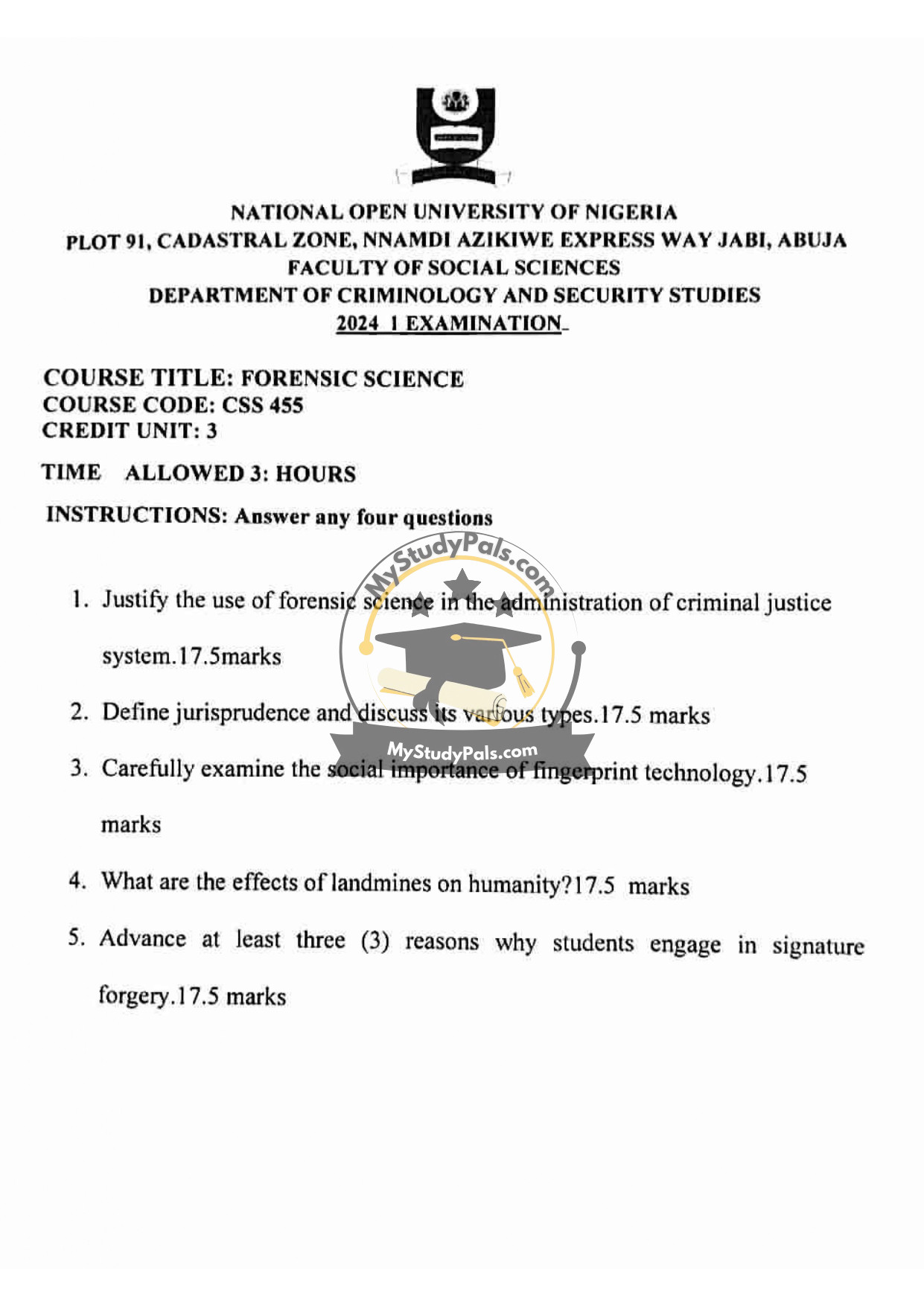ANWSER
—
Question 1:
Answer:
Forensic science plays a critical role in the administration of the criminal justice system by providing scientific methods to investigate crimes, analyze evidence, and establish facts. Its use is justified for the following reasons:
1. Evidence Accuracy: Forensic techniques ensure accurate and reliable evidence, reducing the risk of wrongful convictions.
2. Crime Solving: It aids in identifying suspects, linking them to crime scenes, and reconstructing events.
3. Impartiality: Forensic evidence is objective, minimizing biases that may arise from witness testimonies.
4. Legal Admissibility: Courts rely on forensic findings to uphold justice, as they meet legal standards for admissibility.
5. Deterrence: The use of forensic science deters potential criminals due to the high likelihood of detection.
—
Question 2:
Answer:
Jurisprudence is the theoretical study of law, examining its principles, origins, and societal impact. Its various types include:
1. Analytical Jurisprudence: Focuses on the logical structure of law and its concepts (e.g., rights, duties).
2. Historical Jurisprudence: Studies the evolution of legal systems over time.
3. Philosophical Jurisprudence: Explores ethical and moral foundations of law.
4. Sociological Jurisprudence: Analyzes the relationship between law and society.
5. Comparative Jurisprudence: Compares legal systems across different jurisdictions.
—
Question 3:
Answer:
Fingerprint technology holds significant social importance due to:
1. Identity Verification: It provides a unique and reliable method for identifying individuals, used in passports, banking, and security systems.
2. Crime Investigation: Fingerprints help solve crimes by linking suspects to evidence, enhancing law enforcement efficiency.
3. Prevention of Fraud: It reduces identity theft and fraudulent activities in sectors like immigration and employment.
4. Historical Record: Maintains criminal databases for repeat offender tracking.
5. Public Trust: Enhances confidence in legal and security systems through transparency and accuracy.
—
Question 4:
Answer:
Landmines have devastating effects on humanity, including:
1. Loss of Life and Injury: They cause deaths, severe injuries (e.g., amputations), and long-term disabilities.
2. Economic Disruption: Contaminated land becomes unusable for agriculture or development, impoverishing communities.
3. Psychological Trauma: Survivors and communities face lasting fear, anxiety, and PTSD.
4. Displacement: Forces civilians to flee, creating refugees and destabilizing regions.
5. Child Victims: Unexploded mines often harm children, who mistake them for toys.
—
Question 5:
Answer:
Students engage in signature forgery for reasons such as:
1. Academic Pressure: To falsify documents (e.g., permission slips, grades) under stress to meet expectations.
2. Financial Gain: Forging signatures to access funds or benefits (e.g., scholarships, loans).
3. Avoiding Consequences: To bypass disciplinary actions or attendance requirements.
—
Intervention Projects Question:
Answer:
Five factors influencing the location of intervention projects are:
1. Need Assessment: The area must demonstrate a clear, urgent need for the project.
2. Accessibility: Proximity to transportation and infrastructure for resource delivery.
3. Community Support: Local acceptance and participation ensure sustainability.
4. Safety: The location must be secure for staff and beneficiaries.
5. Resource Availability: Availability of materials, labor, and utilities to execute the project.
—
Project Finance Question:
Answer:
(a)(i) Payback Period (Year-End Cash Flows):
– Project A:
Year 1: 20,000 (Cumulative: 20,000)
Year 2: 36,000 (Cumulative: 56,000)
Year 3: 36,000 (Cumulative: 92,000) → Payback between Year 2-3.
Exact calculation: 2 + (80,000 – 56,000)/36,000 = 2.67 years.
– Project B:
Year 1: 60,000 (Cumulative: 60,000)
Year 2: 24,000 (Cumulative: 84,000) → Payback between Year 1-2.
Exact calculation: 1 + (80,000 – 60,000)/24,000 = 1.83 years.
(ii) Payback Period (Constant Cash Flows):
– Project A: Similar to (i), but adjusted for mid-year recovery: ~2.5 years.
– Project B: ~1.5 years.
(iii) Decision:
– Both projects meet the 3-year payback rule.
– Project B should be selected due to its earlier payback (1.83 years vs. 2.67).
—



